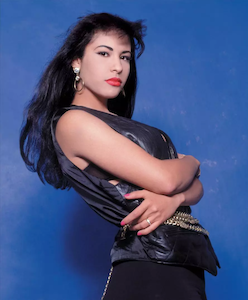
On April 16, 1971 in a small town about 50 miles from Houston, Texas, Selena Quintanilla was born the third child to Abraham Jr. and Marcella Quintanilla. Her father led a Mexican rock band during the 50s and 60s, but he left the music industry to start a family. The family resided in Lake Jackson, and Quintanilla attended Oran M. Roberts Elementary School from kindergarten to fifth grade. With a former-musician father and a loving mother at home, she was already set for fame. After her father discovered that his daughter had a talent for music at the age of six, he began to push her to pursue it. At the time, her father was teaching his eldest son, Abraham III to play guitar as Quintanilla sang. Quintanilla, her brother, and sister created a family band known as Selena y Los Dinos. At the age of 10, Quintanilla became the lead singer of her family’s band. Quintanilla’s brother Abraham III was on bass guitar and her sister Suzette on drums. In the 1980s, her father opened a restaurant, and the band played on weekends. When their musical venture first started, they performed at weddings and clubs throughout Lake Jackson.
Quintanilla’s father began writing Spanish-language songs for the band. Growing up, Quintanilla spoke solely English, but her father taught her to sing in Spanish, so she could connect with her Latinx roots. Quintanilla grasped Spanish phonetically through singing lyrics, but eventually she spoke her family’s language fluently. Locally, Selena y Los Dinos had many fans, but eventually the family restaurant closed down, and her father moved his family to his hometown Corpus Christi, Texas. Quintanilla began attending West Oso Junior High. Around the state, Selena y Los Dinos played and performed their music. The band toured, and it paid off when they performed with a well-known Tejano act called Mazz. Success followed for an eleven year-old Quintanilla, but she often missed class since she focused on her music; by eighth grade, she ceased her education. During 1984, Quintanilla recorded “Mis Primeras Grabaciones” for the Corpus Christi’s Freddie label, which was one of the most established, as well as oldest, Spanish-language record labels in the Texas area. The album had only one single, “Ya Se Va,” but it did not sell well, so Quintanilla switched record labels. She began recording at Cara and Manny record labels, but her albums did not sell well. Living in a van, the band proceeded to tour along larger Tejano acts, in the southwest United States. As time progressed, Selena y Los Dinos learned more styles of music so they could play for different audiences in cities and towns. By 1988, Quintanilla was well-known to the point where she won female artist of the year at the Tejano Music Awards. Quintanilla received this award seven years in a row, and her popularity increased with each win.

As she rose to fame, she began to design all of her stage outfits. She expressed her passion for fashion by making her own clothing, and embellishing beads and other accessories into existing items. She soon developed a fashion boutique under her name to fulfill her dreams of becoming a fashion designer. By 1989, Quintanilla joined EMI Records. The head of the organization’s new Latin division, Jose Behar, noticed that Quinatnilla could appeal to wider audiences besides Tejano fans. That same year, Quintanilla received her GED at the American School in Chicago and enrolled into business administration correspondence at Pacific West University.
In 1990, Quintanilla released her Ven Conmigo album, which sold over 500,000 copies and was the first Tejano record to ever receive gold record status. During 1991, Quintanilla collaborated on a song with Álvaro Torres called “Buenos Amigos” and it became a hit. It went No. 1 on Billboard’s Latin music chart, and this introduced Quintanilla to audiences in the United States. Her popularity widened with the release of “Donde Quiero Que Estes.”
On April 2, 1992, Quintanilla married Christopher Perez, the lead guitarist in her band. Her marriage was not approved by her father, but Quintanilla and Perez hoped to live the rest of their lives together. During 1993, Live! was released and reached No. 2 on the Billboard’s Top Latin Album chart. Following this milestone, Quintanilla became the first female Tejano artist to receive a Grammy for the Best Mexican-American Album category. As Quintanilla’s career skyrocketed, she was often compared to music star Madonna because of their similar stage presence and fashion. Quintanilla’s image mirrored Madonna’s in the early years of her career; these comparisons encouraged Quintanilla to release an English-language album. Quintanilla switched record companies to one that specialized in English-language music, and she began recording.

By 1994, Quintanilla released her third album Amor Prohibido, which went gold that same year. Around this time, she and her band toured in places ranging from New York, California, Puerto Rico, Argentina, to Houston where over 60,000 people saw her perform.
In 1995, Quintanilla released her final album Dreaming of You, which was an English album, containing five songs sung in English. The star hoped and wished to see the album top the charts, but she did not live to see its success. Dreaming of You became a hit and reached No. 1 on the Billboard Top 200 the week of August 5, 1995. This album was released following Quintanilla’s death.
On March 31, 1995, Quintanilla was murdered in Corpus Christi, Texas. She was shot and killed by Yolanda Saldivar, the founder and president of Quintanilla’s fan club. On the day of the murder, Quintanilla met with Saldivar in a hotel to discuss money that had gone missing. Saldivar had a criminal record and was embezzling money from both the fan club and the boutique. When the two met up, Saldivar had been carrying a gun and fatally shot Quintanilla in the abdomen. Due to blood loss, Quintanilla died before she reached the hospital. 100,000 mourners were estimated to have attended Quintanilla’s public viewing in Corpus Christi, Texas.
Following the star’s death, George W. Bush, the then-governor of Texas, announced that the 16th of April (Quintanilla’s birthday) would be celebrated as Selena Day to commemorate her. In Corpus Christi, Texas, a museum includes attributes from Quintanilla’s life, alongside her musical achievements, namely clothing and her collection of nearly 500 Faberge eggs! After Quintanilla’s murder, People magazine printed a tribute to the star, and the issue quickly sold off the shelves. After seeing the popularity of the English-language version, the magazine created a Spanish-language version of the tribute called People en Español.
During her life, Quintanilla often gave back to her community. She spoke in high and middle schools and donated her time as well as money to promote youth education. Quintanilla also worked to educate on drug abuse at the Drug Abuse Resistance Education (D.A.R.E.) program as Spokesperson. Today, a movie (Selena 1997) and a show (Selena: The Series 2020) have been released detailing Quintanilla’s life. Even after her death, Quintanilla continues to become a household name among Latinx families.
Why Did I Choose to Research Selena Quintanilla?
Ever since I was a child, “Selena Quintanilla” was a name that I’ve heard throughout my life. Her music and name has followed me growing up, and she is one of the reasons I’m proud to have a Mexican heritage. Quintanilla has also taught me that not initially knowing Spanish since birth is alright, and taking your time to learn something is what really matters. Through her songs, I better understood and improved my pronunciation of Spanish words to not only enhance my proficiency in the language but reconnect with my family as well as culture. Seeing Quintanilla’s perseverance and success despite her background is something that I find incredibly inspiring. From growing up in poverty to producing songs that reach No. 1 on Billboard’s top Latin music is truly and undeniably moving, and Quintanilla proves that anything is possible.
Works Cited
Biography.com Editors. “Selena Quintanilla.” Biography.com, A&E Networks Television, 8 Oct. 2021, https://www.biography.com/musician/selena.
Facts Chief Modified: 10 Feb 2022, and Facts Chief. “Selena Quintanilla Facts: Love, Death [&] More.” Facts.net, 10 Feb. 2022, https://facts.net/selena-quintanilla-facts/.
“Quintanilla Perez, Selena [Selena] (1971–1995).” TSHA, https://www.tshaonline.org/handbook/entries/quintanilla-perez-selena-selena.
“Selena Biography.” Encyclopedia of World Biography, https://www.notablebiographies.com/Sc-St/Selena.html.
“Selena Quintanilla.” History and Biography, 26 June 2018, https://history-biography.com/selena-quintanilla/.
Leon, Marianeli De. WCW: Selena Quintanilla Pérez, The Advocate, https://mcadvocate.com/15689/opinions/wcw-selena-quintanilla-perez/.
This article was published on 3/3/23